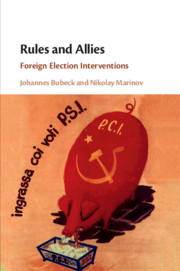Book contents
- Frontmatter
- Contents
- List of Figures
- List of Tables
- Acknowledgements
- 1 Introduction
- 2 Anarchy and Polyarchy
- 3 The Who and the How of Elections: A Theory with Interested Outsiders
- 4 Actors, Policies, Strategies: Original Data on Electoral Interventions
- 5 How Election Interventions Work: A Look at the Evidence
- 6 Captain America
- 7 When Money Runs Low and Regime Overthrow
- 8 Buying Allies
- 9 Conclusion
- Appendix
- References
- Subject Index
- Author Index
6 - Captain America
Published online by Cambridge University Press: 15 July 2019
- Frontmatter
- Contents
- List of Figures
- List of Tables
- Acknowledgements
- 1 Introduction
- 2 Anarchy and Polyarchy
- 3 The Who and the How of Elections: A Theory with Interested Outsiders
- 4 Actors, Policies, Strategies: Original Data on Electoral Interventions
- 5 How Election Interventions Work: A Look at the Evidence
- 6 Captain America
- 7 When Money Runs Low and Regime Overthrow
- 8 Buying Allies
- 9 Conclusion
- Appendix
- References
- Subject Index
- Author Index
Summary
This chapter zooms in on the behavior of a particular intervener: the United States of America. The United States is, as we show, the world's top election intervener. The combination of superpower status with Wilsonian messianism provides powerful incentives to shape democratic fortunes abroad. The United States, even when compared to all other liberal powers, is the actor most committed to free and fair elections around the world. The rise of international organizations, dedicated to election observation and other democratic practices, has increased American pressure for clean contests. In all, cases where the United States and other liberal powers have dominated elections, have seen less bias and more democracy than cases where illiberal powers dominate. Thus, both in terms of policy and in terms of outcomes, America's mission and dedication to free elections stands clear in the empirical record.
Keywords
- Type
- Chapter
- Information
- Rules and AlliesForeign Election Interventions, pp. 149 - 178Publisher: Cambridge University PressPrint publication year: 2019

